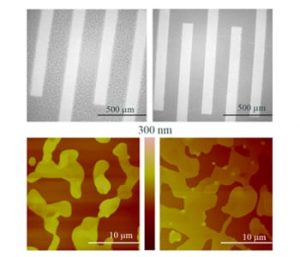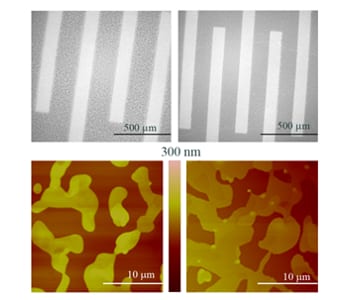
C12-BTBT assemblies within the OFET channel without (first column) and with (second column) ozone treatment.
A straightforward method to fabricate field-effect transistors based on 2,7-didodecyl [1]benzothieno[3,2-b][1]benzothiophene (C12-BTBT) has been reported by Paolo Samorì and co-workers. They used an intense UV/ozone treatment – more efficient and less complex than other existing method – to modify the SiO2 dielectric surface (see figure), and with a simple two-step process obtained a maximum mobility of 2.7 cm2 V-1 s-1.
In the past decade, the effort towards fine-tuning of non-covalent interactions among semiconducting molecules possessing tailor-made physico-chemical properties has boosted the field of organic electronics, thus paving the way towards flexible logic circuits. Extremely high charge carrier mobilities in organic field-effect transistors (OFETs) have been obtained, in particular, by using as the electroactive component small organic molecules that form highly crystalline arrangements. Countless processing and post-processing methods have been devised and applied to solution-processed OFETs in an attempt to control this assembly toward higher mobility, often leading to a rather complex procedure for device fabrication.
Now, publishing in ChemPlusChem, Professor Samorì and his collaborators demonstrate how high-performance organic transistors can be obtained through simple and cheap device fabrication, by improving the charge transport properties of a semiconductor through an incisive ozone treatment of the substrate. “Aiming for full coverage of the transistor channel is a great challenge for some class of molecules”, Samorì says, “and we demonstrated that the enhancement of their affinity for the substrate with one of the simplest treatment we can think of, greatly improves the morphology of the film still preserving the crystalline packing.”

















